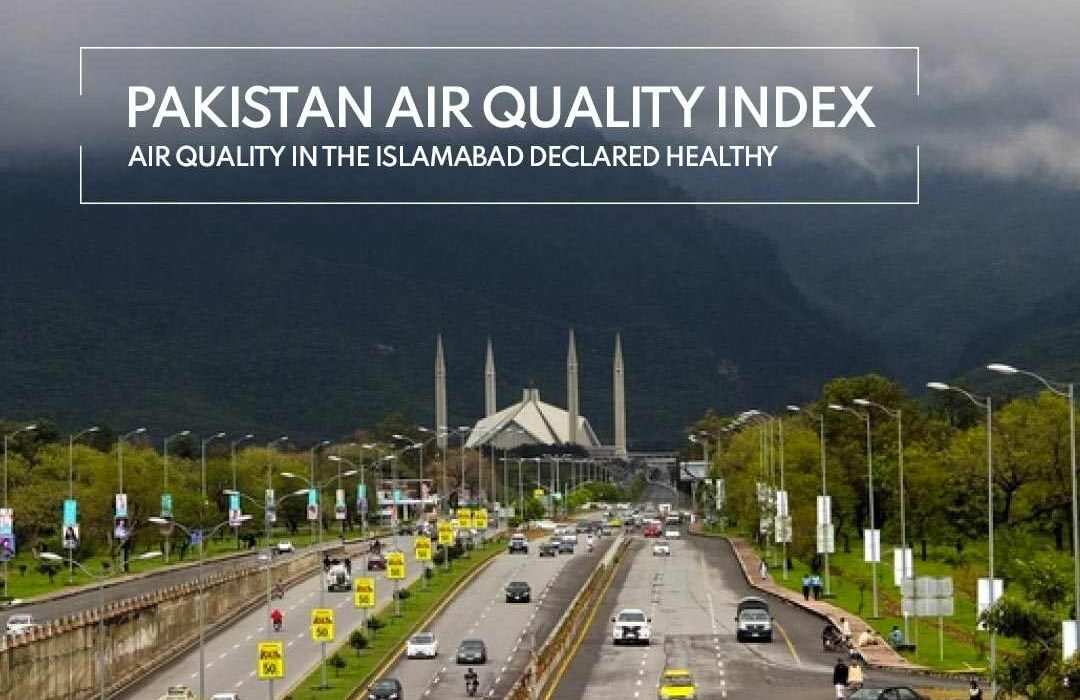Islamabad, the future financial backbone of the country, is known for their air quality… according to the Pakistan EPA, the air pollutant levels in the capital city of Islamabad have reduced significantly, falling below permissible limits, resulting in a healthy air quality.
Despite the dry weather and ongoing development projects in progress on two major roads, air pollution in the metropolis has remained low. The prolonged rainy weather helped contain air pollutants in the atmosphere.
Air Quality in Islamabad
Sustaining air quality in the Pakistan capital city has been under limelight for many years due to the rapid growth and development.
The government has taken initiatives to improve air quality, including the implementation of stricter emissions standards for vehicles and industries, the promotion of public transport, and the introduction of renewable energy sources.
Moreover, the city has also launched several awareness campaigns to educate the public about the air quality and the measures to reduce air pollution.
The Capital Development Authority (CDA) has taken steps to preserve air quality by encouraging the construction of environmentally-friendly structures. As Chakor Ventures, we are contributing to this effort by building Citadel 7, a project approved by the CDA that adheres to the prescribed protocols and standards.
These efforts have given in significant improvements in air quality in recent years, as indicated by lower levels of pollutants in the air.
However, sustained efforts and continued vigilance are necessary to maintain these improvements and ensure a healthy and livable environment for the citizens of Islamabad.
Role of Pakistan Environmental Protection Agency (Pak-EPA)
However, EPA officials have noted that increased vehicular emissions due to the growing number of automobiles on the roads is a leading cause of air pollution in the city.
To address this issue, advanced carbon-absorbing technology has been installed at various steel manufacturing units to reduce industrial emissions.
Despite these efforts, Senior Pulmonologist at Pakistan Institute of Medical Sciences (PIMS), Dr. Zia ul Haq, has highlighted that exposure to dry and cold air while outdoors can damage the respiratory tract lining, leading to infections and respiratory ailments.
Continued efforts to maintain healthy air quality, including reducing vehicular emissions, are necessary to protect public health.
To achieve its goals, the Pak-EPA will need to work with other government agencies, civil society organizations, and the private sector to use policies and programs to help environment.
How Air Quality affects the Overall Environment and People
City air quality can have a significant impact on both the environment and people. Poor air quality adversely effects on the health of individuals, particularly those with pre-existing respiratory or cardiovascular conditions. It include shortness of breath, coughing, and exacerbation of asthma symptoms, among other health effects.
In addition, air pollution can contribute to a range of environmental issues, including climate change, acid rain, and depletion of the ozone layer. Poor air quality can also harm plants and wildlife, and lead to reduced agricultural yields.
Furthermore, air pollution can have economic impacts, such as reduced worker productivity due to health effects and increased healthcare costs. Poor air quality will lead to decreased property values and tourism, which can harm local economies.
Conclusion
The Pakistan Environmental Protection Agency (Pak-EPA) is responsible for protecting the environment in Pakistan.
In the future, the agency is expected to continue its efforts to address the various environmental challenges faced by the country, including air and water pollution, climate change, and deforestation.
Some of the future work of the Pak-EPA may include:
- Strengthening regulations and enforcement mechanisms to ensure compliance with environmental standards
- Conducting research and monitoring to assess the state of the environment and identify emerging issues
- Raising public awareness and promoting environmental education to encourage citizen participation in environmental protection
- Collaborating with international organizations and partners to access funding and technical assistance for environmental projects
- Developing and implementing strategies to mitigate the impact of climate change and reduce greenhouse gas emissions.


